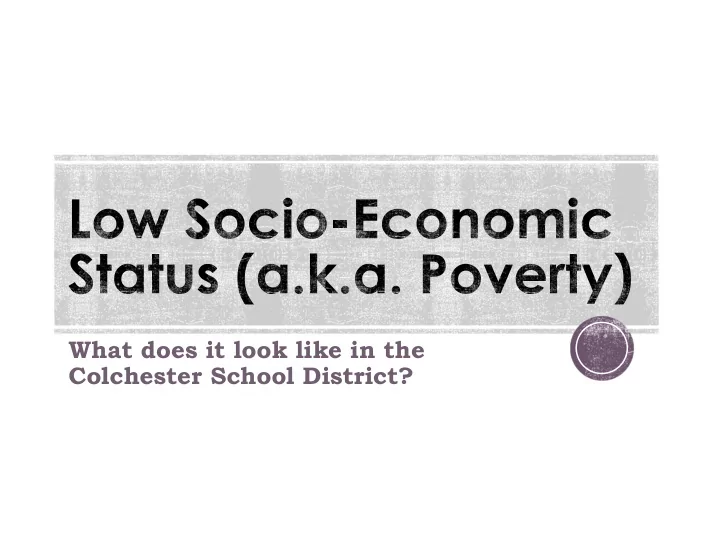

What does it look like in the Colchester School District?
National School Lunch Federal Poverty Guidelines Program FAMILY OF FOUR (2017) FAMILY OF FOUR (2017) $24,600 $45,510 VERMONT RATE (2016) VERMONT RATE (2016) 11.9% 44.1%
50 45 40 40 38 37 36 36 35 35 34 35 32 31 30 28 25 21 20 17 15 10 5 0 2005-06 2006-07 2007-08 2008-09 2009-10 2010-11 2011-12 2012-13 2013-14 2014-15 2015-16 2016-17 2017-18
38 34 32 32 25 PPS UMS MBS CMS CHS
62 32 29 25 20 15 14 Burlington Chittenden Chittenden East Chittenden Colchester Milton South Burlington Central South
Situational poverty – crisis or sudden loss and is often temporary Generational poverty – at least two generations born into poverty Absolute poverty – scarcity of shelter, running water and food (rare in US) Relative poverty – income is insufficient to meet it’s society’s standard of living Urban poverty (metropolitan areas with populations of at least 50,000) – includes additional stressors (crowding, violence and noise) with inadequate services Rural poverty (nonmetropolitan areas with populations below 50,000) – less access to services and job opportunities are fewer
Emotional and Social Challenges Cognitive Lag Health and Safety Issues Acute and Chronic Stressors
• Sadness Joy Hardwired • Disgust Anger • Surprise Fear • Empathy Compassion Taught • Sympathy Patience • Gratitude Cooperation
Smaller Surface Area (as much as 8-10% lower) 20% of achievement gap due to brain development Less healthy food, unsafe neighborhoods promote fight or flight
CA1 Studies have found that by age four, children in middle and upper class families hear 15 million more words than children in working-class families and 30 million more words than children in families on welfare. Psychology Today
Slide 10 CA1 Chris Antonicci, 11/22/2017
Infant Mortality Asthma Overweight and Obesity Type 2 Diabetes Mental Health (emotional and behavioral problems) Increased Adverse Childhood Experiences (ACE)
An ACE score is a tally of different types of abuse, neglect, and other hallmarks of a rough childhood. According to the Adverse Childhood Experiences study, the rougher your childhood, the higher your score is likely to be and the higher your risk for later health problems. ACE QUIZ
60 50 40 Non-poor 30 Poor 20 10 0 0 1 2 3 4 5+
Raised Social Brain-Based Mindfulness Awareness Curriculum Learning Provide Head Homework Healthier All Supplies Start Club Meals
Bergland, C. (2014, February 14). Tackling the “Vocabulary Gap” Between Rich and Poor Children. Psychology Today . Retrieved from https://www.psychologytoday.com/blog/the-athletes-way/201402/tackling-the-vocabulary-gap-between-rich-and-poor-children Burns, M. Effects of Poverty on School Success [Webinar]. In Scientific Learning Fast ForWord Series . Retrieved from https://www.scilearn.com/resources/webinars Haberman, M. (2010, October). The Pedagogy of Poverty Versus Good Teaching. Phi Delta Kappan , 81-87. Jensen, Eric (2009). Teaching with Poverty in Mind: What Being Poor Does to Kids’ Brains and What Schools Can Do About It . Kwon, D. (2015, July 22). Poverty Disturbs Children’s Brain Development and Academic Performance. Scientific American. Retrieved from https://www.scientificamerican.com/article/poverty-disturbs-children-s-brain-development-and-academic-performance/ MacDonald, C., & Figueredo L. (2010, February). Closing the Gap Early: Implementing a Literacy Intervention for At-Risk Kindergartens in Urban Schools. The Reading Teacher , 404-419. Sato, M. & Lensmire, T. (2009, January). Poverty and Payne Supporting Teachers to Work with Children of Poverty. Phi Delta Kappan , 365- 370. Snyder, T. & Musu-Gillette L. (2015, April 16). Free or Reduced Price Lunch: A Proxy for Poverty?. National Center for Educational Statistics . Retrieved from https://nces.ed.gov/blogs/nces/post/free-or-reduced-price-lunch-a-proxy-for-poverty Starecheski, L. (2015, March 2). Take the ACE Quiz – And Learn What It Does and Doesn’t Mean. National Public Radio . Retrieved from https://www.npr.org/sections/health-shots/2015/03/02/387007941/take-the-ace-quiz-and-learn-what-it-does-and-doesnt-mean You Tube. (2013, March 14). The Daily Struggle of America’s “Motel Kids” [Video file]. Retrieved from https://www.youtube.com/watch?v=DpUpXPMT4nI YouTube. (2009, April 30). Two Steps Forward [Video file]. Retrieved from http://www.youtube.com/watch?v=VEkIkdHwvso
Recommend
More recommend